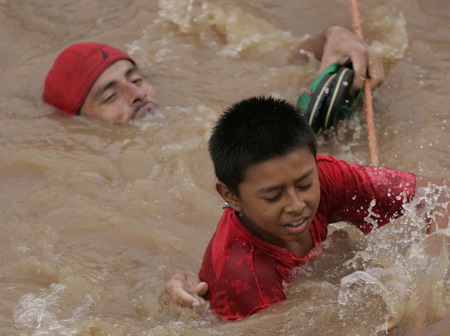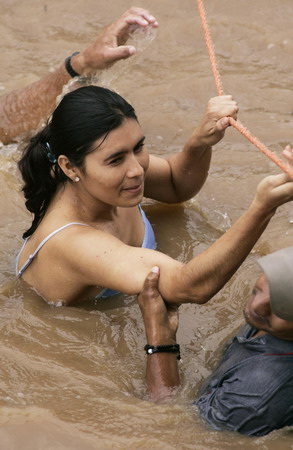Asia-Pacific
Tropical storm kills 86 in Central America
(Agencies)
Updated: 2010-05-31 09:06
 |
Large Medium Small |
|
|
The remnants of Tropical Storm Agatha dumped more rain across Central America on Sunday after killing at least 86 people in the region, sparking fears of further mudslides in three countries.
Agatha, the first named storm of the 2010 Pacific hurricane season, slammed into the Guatemalan coast near the border with Mexico on Saturday.
|
||||
At least 74 people were confirmed dead in Guatemala and the authorities were investigating 20 other reports of fatalities, emergency services spokesman David de Leon said.
More than 74,000 people have fled their homes.
At least 14 people were believed dead in the town of San Antonio Palopo, 90 miles (160 km) southeast of the capital, Guatemala City, after a huge mudslide engulfed an entire neighborhood.
"There was a mudslide that wiped out homes, trees and everything in its path," said a man who gave his name on local radio as Luis.
"We have found 14 bodies and we think there are another eight to 10 beneath the mud."
Rescue workers scrambled to restore communications to towns and villages cut off by landslides where other victims were feared.
The intense rainfall has sparked concern over the condition of the coffee crop in Guatemala, the region's biggest producer, as well as in El Salvador, where the rains fell heaviest in the principal coffee-growing region.
The storm dissipated overnight as it crossed the western mountains of Guatemala but emergency workers warned residents to expect heavy rain for several more days.
Swollen rivers burst their banks and mudslides buried homes in towns and cities alike. A highway bridge near Guatemala City was swept away by the floodwaters and sinkholes opened up in the capital where many neighborhoods remained without electricity.
More than 3 feet (1 metre) of rain fell in parts of Guatemala, said President Alvaro Colom.
"Many places are cut off but it appears the weather will improve a bit today and we will be able to airlift supplies to those places. The road network is badly damaged," Colom said at a news conference.
Nine people were killed in neighboring El Salvador and more than 8,000 were in shelters, President Mauricio Funes said.
Three people were reported killed in Honduras, including a woman electrocuted as she was being evacuated from her flooded home. Officials warned of possible mudslides from saturated hills.
DAMAGE TO COFFEE UNKNOWN
Central America is vulnerable to heavy rains due to mountainous terrain and poor communications in rural areas. Last November's Hurricane Ida caused flooding and mudslides that killed at least 150 people as it moved past the region.
Guatemalan officials warned the flooding from the storm could be worsened by ash spewing out of the Pacaya volcano that has blocked drainage systems.
The volcano, which erupted on Thursday, had already closed the country's main international airport and aviation officials do not expect to finish cleaning ash and debris off the tarmac until at least Tuesday.
The volcano remained active on Sunday but the intensity of the eruption appeared to be diminishing, civil defense officials said.
Pacaya has been active since the 1960s but had not ejected rocks and ash since 1998.
The volcano, 25 miles (40 km) south of Guatemala City, is close to some of Guatemala's most prized coffee plantations.
Coffee farms around the volcano reported some damage to plants but other areas were still out of contact, a spokeswoman for Anacafe, the national coffee association said.
"There is some defoliation and some of the beans have been damaged, but right now we are still working to determine the effect on the crop," Anacafe's Nancy Mendez told Reuters.
El Salvador's national coffee associations said poor communications had so far left it unable to determine the extent of any damage to crops.
|
|





